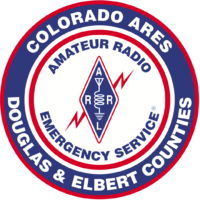Amateur radio operators can perform an invaluable service to their communities during an emergency when the normal channels of communication have been disrupted.
You may be wondering what would be expected of you as an emergency communicator, and the following points should help answer your questions.
- Operating Procedures:
We require completion of our New Member Training Class, which outlines proper communication techniques and procedures. Information on this training can be obtained from the ARESDEC officers.
We also require successful completion of the ARRL ARECC Level 1 training, or successful completion of the Colorado Ares ECOMM training.
Review, practice and understand the Basic Emergency Communication Practices.
Review, practice and understand the Controlled Net Guidelines.
Obtain IS-100.b, IS-200.b, IS-700.a and IS-800.b training.
For training information see Training Requirements. - Equipment Preparedness:
Be able to operate your equipment using batteries (no AC power) for at least 24 hours.
Have a gain antenna (plus mast) and at least 10 Watts of output power to overcome obstacles/terrain.
We recommend a dual band HT and a dual band mobile rig for communications at minimum. To be a valuable, active member of the group, you need to be able to communicate on both VHF and UHF. Our portable emergency repeaters which are frequently used in the field are UHF only. - Personal Preparedness:
Develop a “Go Kit” that includes a 24 hour supply of food/water, warm clothing, pencil/paper, and personal items. - Family Preparedness:
Be able to leave your family knowing they are prepared for you to be away for 8 to 12 hours.
Ready to join? Click here to submit an application.
